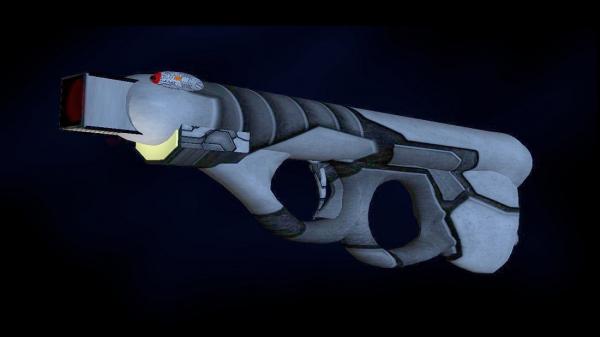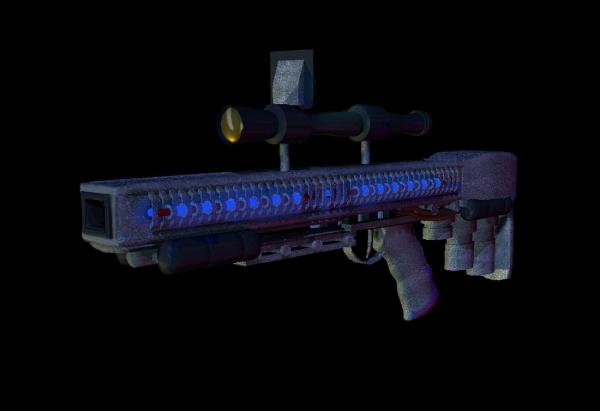BY LETTER
Quadrail Gaussrifle
Technology > Technology Type or Material > Drytech/Hylotech
Technology > Technology Levels > Middle Tech / Midtech
Technology > Application > Weapons > Personal Weapons
Technology > Application > Weapons
Technology > Technology Levels > Middle Tech / Midtech
Technology > Application > Weapons > Personal Weapons
Technology > Application > Weapons
 Image from Steve Bowers | |
| A Quadrail Gaussrifle from the Second Federation era, with forward sensors and DNI aiming/firing systems as well as an optional manual trigger | |
An aerodynamically-shaped projectile can be rotated around its long axis (in the same way that a rifle bullet is spun) for stability. Alternately a spherical projectile can be rotated using X and Y axis control to allow "spinning" or "hooking" of the ball, allowing the gun to apply lift and deflect the path of the projectile (in an atmosphere). This allows the gun to compensate for wind direction and other atmospheric conditions, and to shoot around corners (to a limited extent).
This configuration allows more control over the shape of the magnetic field inside the barrel than a simple coilgun design, where the magnetic coils loop around the barrel. A wide range of ammunition can be used in the Quadrail gaussrifle, including large calibre ball-shaped shot (known as Maxiballs) down to much smaller buckshot rounds, flechettes with two or four fins, bullet-shaped rounds of many kinds including Boom Bullets, and even cubical or rectangular rounds.
After some experimentation with open-framework 'caged' designs, quadrail designs with closed barrels were found to be much safer and more reliable. Rates of fire up to 600 shots per minute are commonplace, although a typical hand-held design will soon use up all its ammunition at this rate. The muzzle velocity of the quadrail gaussrifle is also "tunable", allowing for high-penetration hypersonic rounds or quieter sub-sonic rounds.
The earliest Quadrail gaussrifles were generally in the 'bullpup' configuration, so that projectiles were fed into the 'stock' end of the gaussrifle and accelerated for the full length of the weapon. Projectiles would be cooled before entering the chamber, and the barrel of the gaussrifle could also be actively cooled. Air cooling is possible when operating within a temperate atmosphere, but in a vacuum the gun could eject coolant to cool down.
Gyroscopic stabilisation was also commonplace in these weapons, and is ubiquitous in more modern versions. Modifications of this stabilisation system can be used to ensure targeting accuracy.
 Image from Steve Bowers | |
| Trillicon gaussrifle from the early First Federation era. This early version uses manual firing and a telescopic sight, designed to be resistant to the Malware Plagues that were commonplace in the preceding Dark Age. | |
Related Articles
Appears in Topics
Development Notes
Text by From an original article by Michael Boncher
updated by SeanR, dsmike1980, Ryan B, Todd Drashner, Steve Bowers 2018
Initially published on 25 May 2004.
updated by SeanR, dsmike1980, Ryan B, Todd Drashner, Steve Bowers 2018
Initially published on 25 May 2004.






